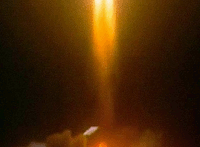Launch of Russia's troubled booster rocket delayed
The launch of Russia's Rockot carrier rocket from Plesetsk spaceport has been postponed. Last year, the rocket failed to take a military satellite into orbit, a source from the space industry of the Russian Federation told Interfax.

"The launch has been delayed due to technical problems with the Breeze-KM upper stage that was designed by Khrunichev's Space Center," an official said.
Rokot booster rocket is supposed to deliver four satellites into orbit: two Gonets-M communication spacecraft, a satellite of Cosmos series as well as MiR microsatellite.
The launches of Rokot booster rockets were suspended after a failed launch on February 1, 2011. An emergency situation occurred at Breeze-KM upper stage when Geo-IK-2 military geodesic satellite was being launched. As a result, the satellite failed to reach orbit.
It was unofficially announced in June that the satellite had been lost. Deputy head of the Federal Space Agency Anatoly Shilov was reprimanded for the failure with Geo-IK-2. The cost of the loss of the satellite has not been reported.
Rockot, which means "Roar" in Russian, is a Russian space launch vehicle that can launch a payload of 1,950 kilograms into a 200 kilometre high Earth orbit with 63° inclination. It is a derivative of the UR-100N (SS-19 Stiletto) intercontinental ballistic missile (ICBM), supplied and operated by Eurockot Launch Services. The first launches started in the 1990s from Baikonur Cosmodrome out of a silo. Later commercial launches commenced from Plesetsk Cosmodrome using a launch ramp specially rebuilt from one for the Kosmos-3M rocket. The cost of a commercial launch is about $14 million.
Rokot's total mass is 107 tonnes, its length 29 metres and its maximum diameter 2.5 metres. The liquid-fueled rocket comprises three stages. The lower two are based on the Soviet UR-100N ICBM; the first stage uses an RD-244 engine, while the second stage uses an RD-235. The third stage is a Briz-KM (Russian: Бриз-КМ meaning Breeze-KM), which has a mass of about 6 tonnes when fuelled, and is capable of flying for 7 hours and reigniting its engine six times during flight, allowing different satellites to be placed into different orbits. All stages use UDMH (unsymmetrical Dimethylhydrazine) as fuel and dinitrogen tetroxide as oxidiser. The Strela is a similar rocket, also based on the SS-19.
Subscribe to Pravda.Ru Telegram channel, Facebook, RSS!





